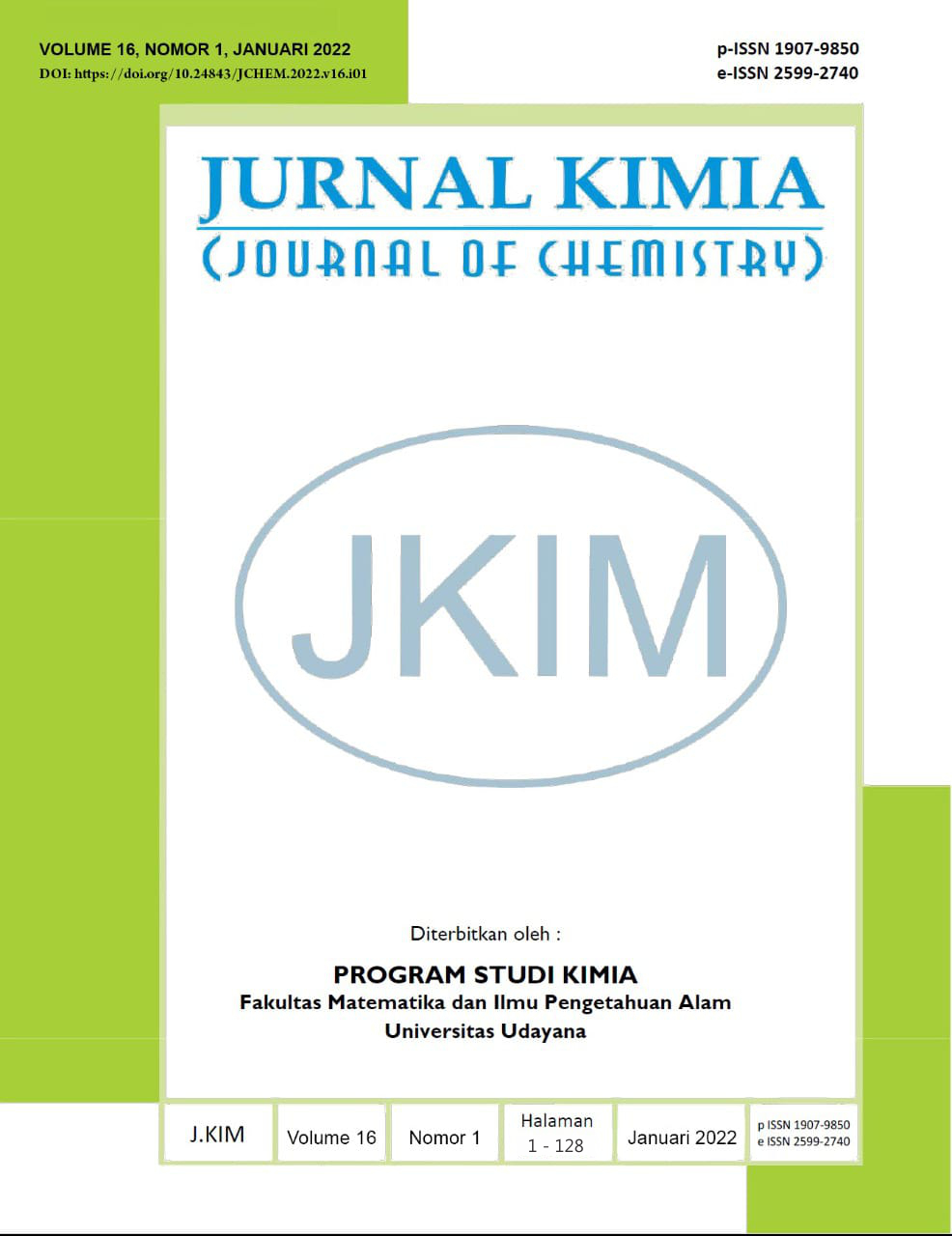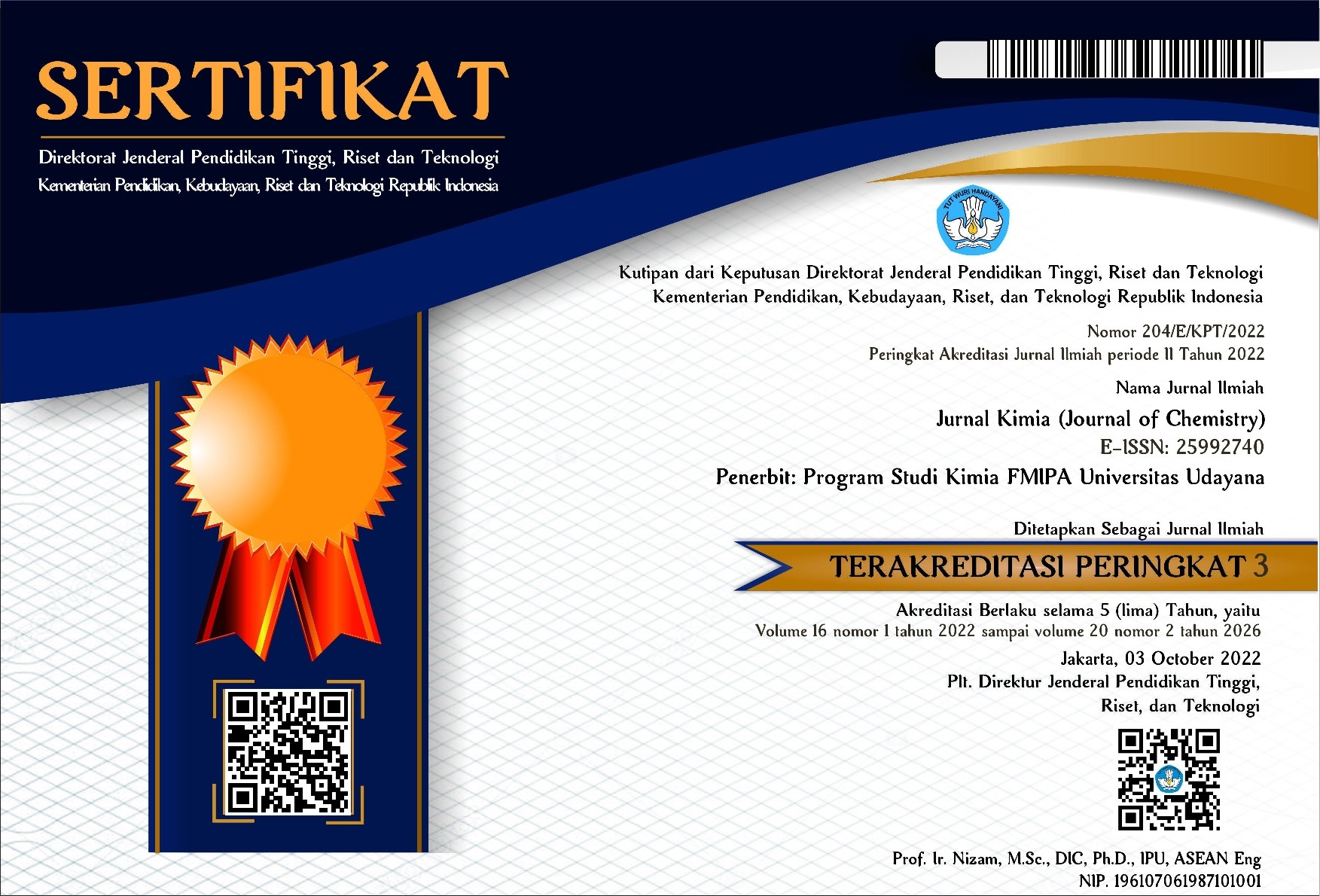MOLECULAR DOCKING SENYAWA XANTON, BENZOFENON, DAN TRITERPENOID SEBAGAI ANTIDIABETES DARI EKSTRAK TUMBUHAN GARCINIA COWA
Abstract
Diabetes mellitus tipe 2 disebabkan oleh ekspresi PTP1B yang tinggi dan mempengaruhi aktivitas PTKs, yang menyebabkan insulin gagal berikatan dengan reseptor insulin dan menginduksi resistensi insulin. Senyawa xanton dan benzofenon merupakan senyawa yang telah diketahui memiliki aktivitas farmakologi sebagai antidiabetes. Salah satu tanaman dengan kandungan senyawa tersebut adalah Garcinia cowa. Penelitian ini dilakukan dengan tujuan untuk mengetahui afinitas dan mekanisme inhibisi PTP1B oleh senyawa turunan xanton, benzofeno, dan triterpenoid dalam Garcinia cowa antara lain garcinia cowone K, guttiferone I, 1,7-dihydroxyxanthone, 1-hydroxyl-7-methoxyxanthone, mangostinone, ?-mangostin, cowanol, gacibiphenyl C, friedelin, ?-friedelinol, dan oleanane-12-ol secara in silico dengan molecular docking serta melakukan studi pre-ADMET terhadap senyawa tersebut. Molecular docking dilakukan melalui beberapa tahap diantaranya preparasi dan optimasi struktur 3D senyawa uji, preparasi struktur 3D reseptor PTP1B, validasi metode, dan docking senyawa uji dengan PTP1B. Hasil yang diperoleh dari docking senyawa uji dengan reseptor PTP1B berupa energi ikatan, konstanta inhibisi (KI), dan ikatan hidrogen. Semakin rendah nilai energi ikatan menunjukkan ikatan antara protein dan ligan yang dihasilkan semakin stabil. Hasil penelitian menunjukkan energi ikatan dan KI PTP1B dengan native ligand berturut-turut sebesar -10,07 kkal/mol dan 0,0417 ?M. Sementara dengan senyawa ?-mangostin berturut-turut sebesar -8,91 kkal/mol dan 0.29317 ?M. Hal tersebut menunjukkan bahwa senyawa ?-mangostin memiliki potensi sebagai antidiabetes mellitus tipe 2 dengan menghambat PTP1B. Selain itu, senyawa ?-mangostin juga memiliki profil ADMET yang baik.
Kata kunci: antidiabetes, diabetes mellitus tipe 2, penambatan molekuler, PTP1B, Xanton
Type 2 diabetes mellitus is caused by high PTP1B expression and affects the activity of PTKs, which causes insulin to fail to bind to insulin receptors, and induces insulin resistance. Xanthones and benzophenones are compounds that have been known to have pharmacological activity as antidiabetic. One of the plants containing these compounds is Garcinia cowa. This study aims to know the affinity and inhibition mechanism of PTP1B by xanthones, benzophenones, and triterpenoid in Garcinia cowa, including garcinia cowone K, guttiferone I, 1,7-dihydroxyxanthone, 1-hydroxyl-7 methoxyxanthone, mangostinone, ?-mangostin, cowanol, gacibiphenyl C, friedelin, ?-friedelinol, and oleanane-12-ol in silico by molecular docking and conducted a pre-ADMET study of these compounds. Molecular docking is carried out in several steps including preparation and optimization of the 3D structure of the compound, preparation of the PTP1B receptor 3D structure, method validation, and docking of the compound with PTP1B. The results obtained from the docking of the compound with the PTP1B receptor appears in the form of bond energies, inhibition constant (IC), and hydrogen bonds. The lower the bond energy value, the more stable the bond between the protein and the resulting ligand is. The results showed that the bond energy and IC value of PTP1B with the native ligand is -10,07 kcal/mol and 0,0417 ?M. Meanwhile the ?-mangostin compound is -8,91 kcal/mol and 0,29317 ?M. It shows that the ?-mangostin has potential as an antidiabetic mellitus type 2 agent by inhibiting PTP1B. In addition, ?-mangostin also shows a good ADMET profile.
Keywords: antidiabetic, molecular docking, PTP1B, type 2 diabetes mellitus, xanthones
Downloads
References
American Diabetes Association. 2009. Multiple Doses of Trodusquemine Improve Glucose Tolerance in Type 2 Diabetic Subjects. Tersedia secara online https://professional.diabetes.org/abstract/multiple-doses-trodusquemine-improve-glucose-tolerance-type-2-diabetic-subjects [Diakses pada 28 Maret 2021].
Bertilsson, L., Dahl, M.-L., Dal´en, P., dan Al-Shurbaji, A. 2002. Molecular genetics of CYP2D6: clinical relevance with focus on psychotropic drugs. Br. J. Clin. Pharmacol. 53: 111–122.
Cheng, J., Palva, A.M., de Vos, W.M., dan Satokari, R. 2013. Contribution of the intestinal microbiota to human health: from birth to 100 years of age. Curr Top Microbiol Immunol. 358: 323-46
Dai, D., Tang, J., Rose, R., Hodgson, E., Bienstock, R.J., Mohrenweiser, H.W., dan Goldstein, J.A. 2001. Identification of variants of CYP3A4 and characterization of their abilities to metabolize testosterone and chlorpyrifos. J. Pharmacol. Exp. Ther. 299: 825–831.
Fatimah, R.N. 2015. Diabetes Melitus Tipe 2. J Majority. 4(5): 93-99.
Fitriasari, A., Wijayanti, N. K., Ismiyati, N., Dewi, D., Kundarto, W., A. Sudarmanto, B. S., dan Meiyanto, E. 2008. Studi Potensi Kurkumin dan Analognya sebagai Selective Estrogen Receptor Modulator (SERMs): Docking pada Reseptor Estrogen ß. Pharmacon. 9(1).
Foti, R.S dan Wahlstrom, J.L. 2008. CYP2C19 inhibition: the impact of substrate probe selection on in vitro inhibition profiles. Drug Metab. Dispos. 36: 523–528.
Heyne, K. 1987. Tumbuhan Berguna Indonesia Jilid III. Jakarta: Yayasan Sarana Wana Jaya.
Huey, R., Morris, G. M., dan Forli, S. 2012. Using AutoDock 4 and AutoDock Vina with AutoDockTools: A Tutorial, California: The Scripps Research Institute.
Istyastono, E. P. 2018. Rancangan Obat dan Penapisan Virtual Berbasis Struktur. Yogyakarta: Sanata Dharma University Press.
Jain, A. J., dan Nicholls, A. 2008. Recommendations for evaluational methods. J. Comput. Aided Mol. 22: 133-139.
Kitchen, D. B., Decornez, H., Furr, J. R., dan Bajorath, J. 2004. Docking and Scoring in Virtual Screening in Drug Discovery, Methods and Applications. Nat. Rev. Drug Discov. 3: 935-949
Kumar, R., Giri, A., Nadendla, R.R. 2018. In Silico ADME Profiling of CDK9 Inhibitors. Journal of Scientific Research in Pharmacy. 7(3): 30-4.
Ma, XI., Chen, C., dan Yang, J. 2005. Predictive model of blood-brain barrier penetration of organic compounds. Acta Pharmacologica Sinica. 26: 500–512.
Manna, A., Laksitorini, M. D., Hudiyanti, D., dan Siahaan, P. 2017. Molecular Docking of Interaction between E-Cadherin Protein and Conformational Structure of Cyclic Peptide ADTC3 (Ac-CADTPC-NH2) Simulated on 20 ns. Journal of Scientific and Applied Chemistry. 20(1): 30-36.
Nursamsiar, N., Toding, A. T., dan Awaluddin, A. 2016. Studi In Silico Senyawa Turunan Analog Kalkon dan Pirimidin Sebagai Antiinflamasi: Prediksi Absorpsi, Distribusi, dan Toksisitas. PHARMACY. 13(1): 92-100.
Olokoba, A.B, Obateru, O.A, dan Olokoba, L.B. 2012. Type 2 Diabetes Mellitus: A Review. of Current Trends. Oman Medical Journal. 27(4).
Oyesakin Y.M., George D.E., Fadare R.Y., Idris A.Y., dan Fadare O.A. 2018. Molecular Docking and In-Silico ADME Prediction of Substituted (E)-4-Styryl-7,8-dihydroquinazolin-5(6H)-ones and 5-((E)-Styryl)pyrimidine[4,5-d]pyrimidine-2,4(1H,3H)-diones as Potential SERT Inhibitors and Antidepressants. American Journal of Pharmacological Sciences. 6(1): 25-32.
Phukatmuen, P., Raksat, A., Lapookhieo, S., Charoensup, R., Duangyod, T., dan Maneerat, W. 2020. Bioassay-guided isolation and identification of antidiabetic compounds from Garcinia cowa leaf extract. Heliyon. 6(4).
Prasetiawati, R., Suherman, M., Permana, B., dan Rahmawati. 2021. Molecular Docking Study of Anthocyanidin Compounds Against Epidermal Growth Factor Receptor (EGFR) as Anti-Lung Cancer. Indonesian Journal of Pharmaceutical Science and Technology. 8(1): 8-20.
Purwaniati. 2020. Studi Docking Molekul Aktivitas Obat COVID-19 dari Derivat N-(2-phenylethyl)methanesulfonamide sebagai Inhibitor Main Protease. Ad-Dawaa’ J. Pharm. Sci. 3(1): 1 – 11.
Ratwita, W., Sukandar E. Y., Asnyana, K., dan Kurniawati, N. F. Alpha Mangostin and Xanthone Activity on Fasting Blood Glucose, Insulin and Langerhans Islet of Langerhans in Alloxan Induced Diabetic Mice. Pharmacognosy Journal. Vol. 11(1): 64-68.
Sun, J., Qu, C., Wang, Y., Huang, H., Zhang, M., dan Zou, W. 2016. Type 2 Diabetes Mellitus and Protein-Tyrosine Phosphatase 1b. Journal of Diabetes, Metabolic Disorders & Control. 3(8): 180-183.
Umamaheswari, M., Madeswaran, A., and Asokkumar, K., 2013. Virtual Screening Analysis and In-vitro Xanthine Oxidase Inhibitory Activity of Some Commercially Available Flavonoids. Iranian Journal of Pharmaceutical Research : IJPR. 12(3): 317–323.
Van Booven, D., Marsh, S., McLeod, H., Carrillo, M.W., Sangkuhl, K., Klein, T.E., dan Altman, R.B. 2010. Cytochrome P450 2C9-CYP2C9. Pharmacogenet. Genomics. 20: 277–281.

This work is licensed under a Creative Commons Attribution 4.0 International License






